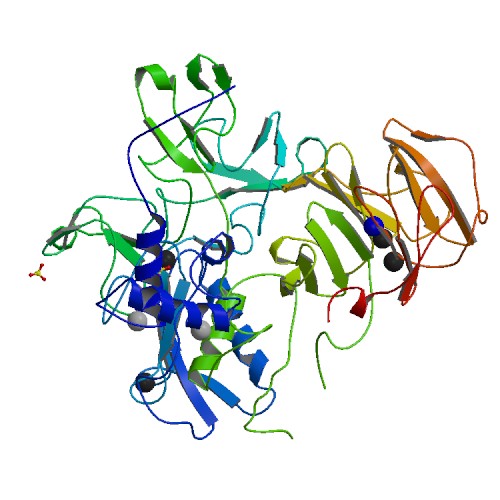Winchester syndrome: Difference between revisions
No edit summary |
No edit summary |
||
| Line 29: | Line 29: | ||
==Differentiating from other diseases== | ==Differentiating from other diseases== | ||
Winchester syndrome should be differentiated from [[rheumatoid arthritis]].<ref name="pmid4238825">{{cite journal |author=Winchester P, Grossman H, Lim WN, Danes BS |title=A new acid mucopolysaccharidosis with skeletal deformities simulating rheumatoid arthritis |journal=Am J Roentgenol Radium Ther Nucl Med |volume=106 |issue=1 |pages=121–8 |year=1969 |pmid=4238825}}</ref> | Winchester syndrome should be differentiated from [[rheumatoid arthritis]].<ref name="pmid4238825">{{cite journal |author=Winchester P, Grossman H, Lim WN, Danes BS |title=A new acid mucopolysaccharidosis with skeletal deformities simulating rheumatoid arthritis |journal=Am J Roentgenol Radium Ther Nucl Med |volume=106 |issue=1 |pages=121–8 |year=1969 |pmid=4238825}}</ref> | ||
==Diagnosis== | ==Diagnosis== | ||
The main characteristics are [[short stature]], marked [[contracture]]s of joints, opacities in the [[cornea]], a coarse face, dissolution of the [[carpal]] and [[tarsal]] bones (in the hands and feet respectively) and [[osteoporosis]]. Appearances resembled [[rheumatoid arthritis]]. Increased [[uronic acid]] was demonstrated in cultured [[fibroblast]]s from the skin and to a lesser degree in both parents. Despite initial tests not showing increased mucopolysaccharide excretion, the disease was regarded as a [[mucopolysaccharidosis]].<ref name="pmid4238825"/> | |||
Revision as of 13:10, 27 July 2012
| Torg-Winchester syndrome | |
 | |
|---|---|
| Matrix Metalloproteinase 2 | |
| OMIM | 259600 |
Editor-In-Chief: C. Michael Gibson, M.S., M.D. [1]; Associate Editor(s)-in-Chief: Raviteja Guddeti, M.B.B.S. [2]
Overview
Winchester syndrome in a rare congenital connective tissue disease.
Historical perspective
It was first described in 1969.
Pathophysiology
In 2005 a patient with Winchester syndrome was shown to have mutations in the matrix metalloproteinase 2 (MMP2) gene.[1] A 2006 study showed other mutations in the same gene, and observed that Winchester syndrome is probably part of a continuum that also includesTorg syndrome and nodulosis-arthropathy-osteolysis syndrome (NAO).[2]
Differentiating from other diseases
Winchester syndrome should be differentiated from rheumatoid arthritis.[3]
Diagnosis
The main characteristics are short stature, marked contractures of joints, opacities in the cornea, a coarse face, dissolution of the carpal and tarsal bones (in the hands and feet respectively) and osteoporosis. Appearances resembled rheumatoid arthritis. Increased uronic acid was demonstrated in cultured fibroblasts from the skin and to a lesser degree in both parents. Despite initial tests not showing increased mucopolysaccharide excretion, the disease was regarded as a mucopolysaccharidosis.[3]
References
- ↑ Zankl A, Bonafé L, Calcaterra V, Di Rocco M, Superti-Furga A (2005). "Winchester syndrome caused by a homozygous mutation affecting the active site of matrix metalloproteinase 2". Clin. Genet. 67 (3): 261–6. doi:10.1111/j.1399-0004.2004.00402.x. PMID 15691365.
- ↑ Rouzier C, Vanatka R, Bannwarth S; et al. (2006). "A novel homozygous MMP2 mutation in a family with Winchester syndrome". Clin. Genet. 69 (3): 271–6. doi:10.1111/j.1399-0004.2006.00584.x. PMID 16542393.
- ↑ 3.0 3.1 Winchester P, Grossman H, Lim WN, Danes BS (1969). "A new acid mucopolysaccharidosis with skeletal deformities simulating rheumatoid arthritis". Am J Roentgenol Radium Ther Nucl Med. 106 (1): 121–8. PMID 4238825.